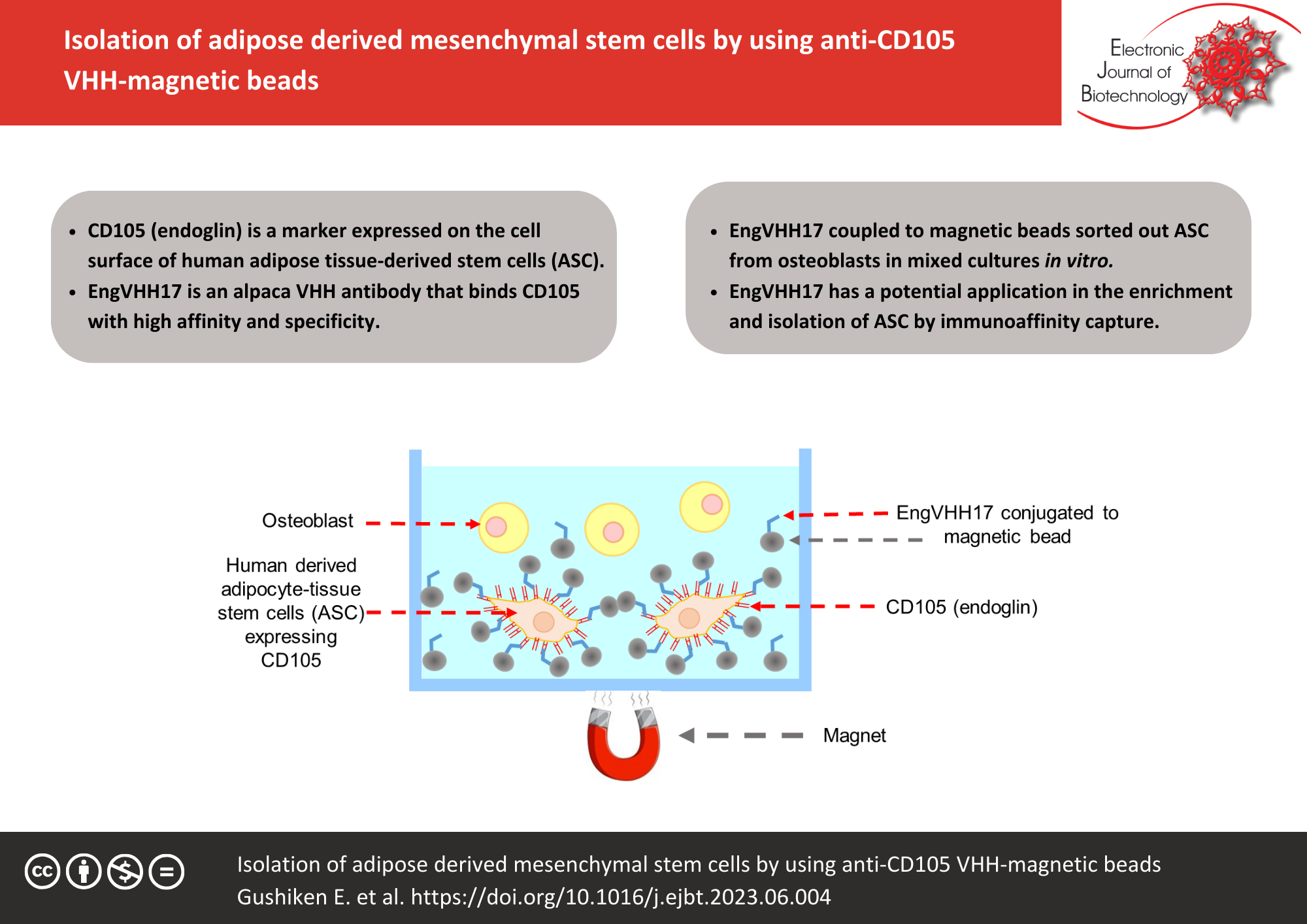Abstract
Background: Human adipose tissue-derived stem cells (ASCs) are widely used in regenerative medicine and tissue engineering. Magnetic-activated cell sorting (MACS) with monoclonal antibodies (mAbs) that bind surface markers of stem cells such as CD105, CD73, and CD90 is currently applied for the enrichment and isolation of ASCs. Alternatives to mAbs are the variable domains of heavy chain antibodies (VHHs), which are naturally produced in camelids. We report the application of an anti-CD105 VHH conjugated to magnetic beads in the isolation of ASCs in vitro.
Results: Two identical anti-CD105 VHHs (EngVHH17) were screened by phage display from a VHH cDNA library constructed from the PBMCs of an alpaca immunized with a lysate of human bladder cancer cell line (T24 cells). EngVHH17 was cloned in pET22b(+), expressed in Escherichia coli BL21 and purified in Ni-NTA chromatography resulting in a ∼15 kDa VHH antibody. EngVHH17 binds CD105 with high affinity (Kd = 3.9 × 10−10 M). The specific binding of EngVHH17 to CD105 was visualized by fluorescence inmunolabeling of phorbol-12-myristate-13-acetate (PMA)-differentiated THP1 cells using FITC labeled anti-6 × His Tag IgG1 mouse mAb. EngVHH17-magnetic beads selectively sorted human ASCs from osteoblasts in a mixed culture in vitro. The selective recovery of ASC cells using different ASC/Osteoblast ratios was higher than 85%.
Conclusions: EngVHH17 coupled to magnetic beads binds CD105 expressed on the cell surface of ASCs and isolates them from osteoblasts in mixed cultures in vitro by application of an external magnetic field. EngVHH17 can be further evaluated for the isolation of MSCs by MACS.
References
Bourin P, Bunnell BA, Casteilla L, et al. Stromal cells from the adipose tissue-derived stromal vascular fraction and culture expanded adipose tissue-derived stromal/stem cells: a joint statement of the International Federation for Adipose Therapeutics and Science (IFATS) and the International Society for Cellular Therapy (ISCT). Cytotherapy 2013;15(6):641-648. https://doi.org/10.1016/j.jcyt.2013.02.006 PMid: 23570660
Brown C, McKee C, Bakshi S, et al. Mesenchymal stem cells: Cell therapy and regeneration potential. J Tissue Eng Regen Med 2019;13(9):1738-1755. https://doi.org/10.1002/term.2914 PMid: 31216380
Balmayor ER, Pashkuleva I, Frias AN, et al. Synthesis and functionalization of superparamagnetic poly-?-caprolactone microparticles for the selective isolation of subpopulations of human adipose-derived stem cells. J R Soc Interface 2011;8(59):896-908. https://doi.org/10.1098/rsif.2010.0531 PMid: 21208971
Nicodemou A, Danisovic L. Mesenchymal stromal/stem cell separation methods: Concise review. Cell Tissue Bank 2017;18:443-460. https://doi.org/10.1007/s10561-017-9658-x PMid: 28821996
Muyldermans S. Nanobodies: Natural single-domain antibodies. Annu Rev Biochem 2013;82:775-797. https://doi.org/10.1146/annurev-biochem-063011-092449 PMid: 23495938
Muyldermans S. A guide to: Generation and design of nanobodies. FEBS J 2021;288(7):2084-2102 https://doi.org/10.1111/febs.15515 PMid: 32780549
Samoilovich MP, Pinevich AA, Vartanyan NL, et al. Endoglin expression in non-tumor and tumor cells of different origin. Cell Tissue Biol 2018;12:437-447. https://doi.org/10.1134/S1990519X18060111
Quintana M, Espinoza JR, Roupioz Y. Production of endoglin-specific heavy chain antibody fragments (VHHs) microarrays for whole-cell SPR imaging. Sensors and Actuators Reports 2022;4:100131. https://doi.org/10.1016/j.snr.2022.100131
Liu W, Song H, Chen Q, et al. Recent advances in the selection and identification of antigen-specific nanobodies. Mol Immunol 2018;96:37-47. https://doi.org/10.1016/j.molimm.2018.02.012
Schneider S, Unger M, van Griensven M, et al. Adipose-derived mesenchymal stem cells from liposuction and resected fat are feasible sources for regenerative medicine. European Journal of Medical Research 2017;22:17 https://doi.org/10.1186/s40001-017-0258-9 PMid: 28526089
Lv X, Zhou G, Liu Y, et al. In vitro proliferation and differentiation of adipose-derived stem cells isolated using anti-CD105 magnetic beads. Int J Mol Med 2012;30(4):826-834. https://doi.org/10.3892/ijmm.2012.1063 PMid: 22825748
Angel-Mosqueda D, Gutierrez-Puente Y, López-Lozano AP, et al. Epidermal growth factor enhances osteogenic differentiation of dental pulp stem cells in vitro. Head Face Med 2015;11:29. https://doi.org/10.1186/s13005-015-0086-5 PMid: 26334535
Mo F, Duan S, Jiang X, et al. Nanobody-based chimeric antigen receptor T cells designed by CRISPR/Cas9 technology for solid tumor immunotherapy. Signal Transduct Target Ther 2021;6:80. https://doi.org/10.1038/s41392-021-00462-1 PMid: 33627635

This work is licensed under a Creative Commons Attribution 4.0 International License.
Copyright (c) 2023 Electronic Journal of Biotechnology

